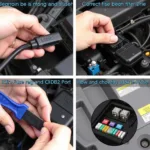“Where is the OBD2 connector?” It’s a common question for car owners venturing into the world of vehicle diagnostics. This guide provides a comprehensive overview of the OBD2 connector location, its functions, and tips for easy identification.
Understanding the OBD2 Connector
The OBD2 connector, also known as the diagnostic port, is a standardized 16-pin interface found in most vehicles manufactured after 1996. This port acts as the gateway to your car’s computer system, allowing you to access a wealth of data about your vehicle’s health, performance, and emissions.
Why is the OBD2 Connector Location Important?
Locating your OBD2 port is essential for:
- Vehicle Diagnostics: Connect an OBD2 scanner to read and interpret diagnostic trouble codes (DTCs), revealing potential issues with your vehicle’s engine, transmission, emissions system, and more.
- Performance Monitoring: Track various parameters like speed, RPM, fuel economy, engine load, and coolant temperature, providing insights into your car’s performance.
- Emission Testing: Verify your vehicle’s emissions compliance during inspections.
Common OBD2 Connector Locations
While the OBD2 standard dictates a universal connector, the location can vary significantly depending on the make, model, and year of your vehicle.
Here are some of the most common places to find your OBD2 connector:
1. Under the Dashboard (Driver’s Side)
This is the most frequent location for the OBD2 port. Look beneath the steering wheel area for a trapezoidal-shaped connector with 16 pins.
2. Near the Steering Column
Some manufacturers place the connector directly on or around the steering column for easy access.
3. Inside the Center Console
Check the area beneath the armrest or within compartments inside the center console.
4. Below the Ashtray
In some vehicles, the OBD2 port might be hidden beneath the ashtray or cigarette lighter panel.
5. Behind a Panel or Trim
Occasionally, manufacturers conceal the connector behind a removable panel. Look for a small panel that might house the OBD2 port.
Tips for Finding Your OBD2 Connector
- Consult Your Owner’s Manual: The most reliable source of information is your vehicle’s owner’s manual. It often provides a diagram or specific instructions on locating the OBD2 port.
- Use Online Resources: Several websites and forums dedicated to car repair and maintenance offer location guides based on make and model.
- Look for the Label: The OBD2 connector is sometimes labeled “OBD,” “OBD II,” or “Diagnostic.”
- Follow the Data Link Connector (DLC) Symbol: Some vehicles use a standardized symbol to indicate the DLC, which houses the OBD2 port.
Troubleshooting: What if You Can’t Find the Connector?
If you’ve exhausted all options and still can’t find the OBD2 connector, consult a qualified mechanic or contact your vehicle’s manufacturer for assistance.
Conclusion
Locating your vehicle’s OBD2 connector is the first step towards unlocking valuable information about your car’s health and performance. Whether you’re troubleshooting a warning light, monitoring vital stats, or simply want to be more informed about your vehicle, knowing where to find this crucial port is essential.

